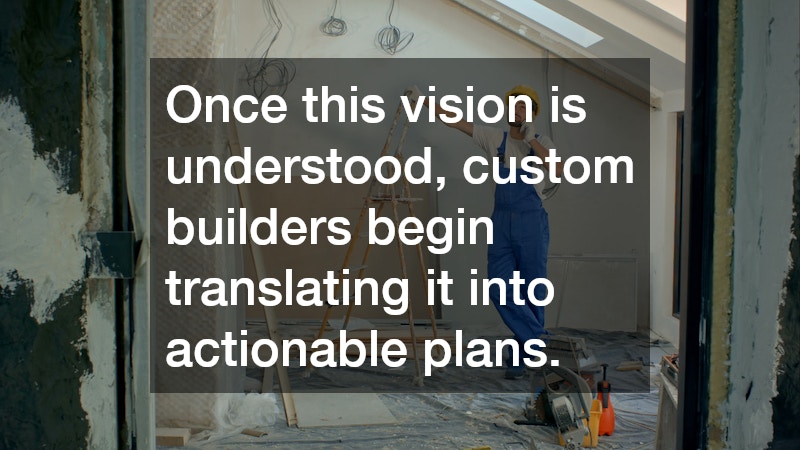Custom home builders are adept at comprehending the unique vision each client brings to the table. They engage deeply with clients to extract every detail, from the broad strokes of architectural style to the nuanced preferences in materials and finishes. This meticulous engagement process ensures that the builder fully appreciates the lifestyle, aesthetic preferences, and functional needs that will inform the home’s design.
By asking targeted questions and encouraging collaborative dialogues, builders create a solid foundation for a successful partnership. Many clients find that this level of focused communication is what truly sets custom home builders apart from more generic options.
Once this vision is understood, custom builders begin translating it into actionable plans. They use a variety of tools, ranging from traditional sketches to advanced CAD (Computer-Aided Design) software, to transform conceptual ideas into tangible blueprints. These blueprints are often the first physical manifestation of the client’s dreams and serve as crucial reference points throughout the building process. Moreover, these plans are dynamic, allowing for adjustments as new ideas or constraints arise, thereby maintaining the integrity of the initial vision. This adaptability is a hallmark of successful custom building projects.
In addition to technical plans, builders also provide mood boards and material samples to fine-tune the home’s aesthetic. This aspect of the process involves selecting color palettes, textures, and finishes that resonate with the client’s vision. By working with interior designers and other specialists, custom home builders ensure that every aspect of the home reflects the client’s personal style. The ultimate goal is to create a cohesive, personalized environment that tells the unique story of its inhabitants. This attention to detail is what transforms a house into a bespoke home.
The Role of Custom Home Builders in Planning and Design
Once the vision is clear, custom home builders move into the planning and design stage, a crucial step in bringing that vision to life. This stage involves coordinating with architects, engineers, and various specialists to create a comprehensive plan. Builders ensure that every detail aligns with the client’s wants, needs, and budget, resulting in a feasible and coherent design. This process also involves rigorous checks for compliance with local zoning laws and building regulations, as well as sustainability standards. By managing these aspects, builders mitigate potential issues that could derail the project later on.
Custom home builders also play an integral role in selecting the right materials and technologies for the project. This selection is not merely about aesthetics; it requires a deep understanding of the best construction practices and emerging trends. Builders recommend materials that offer the best combination of durability, cost-effectiveness, and aesthetic appeal to ensure a long-lasting and beautiful home. This guidance extends to energy-efficient technologies and sustainable building practices that can reduce a home’s environmental footprint. By integrating these elements into the design, builders help the clients achieve important lifestyle goals, such as energy savings and eco-friendliness.
Throughout the planning and design phase, builders maintain close communication with clients to ensure that the project remains aligned with their preferences. Regular updates and design reviews enable clients to see how their vision is moving closer to reality. This transparency builds trust and confidence, essential components of successful custom home projects. It also allows for real-time adjustments to the design, accommodating new ideas or needs as they arise. Ultimately, this collaborative approach to planning stakes a precise pathway from vision to creation.
Executing the Build: Bringing Designs to Life
With a comprehensive plan in place, custom home builders transition to the execution phase, where the vision starts to materialize. This involves managing a complex web of activities, ranging from site preparation and foundation work to structural assembly and finishing touches. The ability to skillfully coordinate various trades and subcontractors is critical in this phase, ensuring that every component of the building project is executed seamlessly. Builders act as the central point of contact, facilitating communication between the client, architects, and tradespeople. This level of management is integral to maintaining the timeline and quality of a custom home build.
Quality control is a paramount concern during the building phase, and custom home builders employ rigorous standards to ensure each detail meets the client’s specifications. Regular inspections and assessments are conducted to verify that the construction aligns with the design and that safety standards are strictly adhered to. Builders also focus on resolving any issues promptly, whether they stem from logistical challenges or design modifications. This proactive approach reduces delays and cost overruns, ensuring that the project proceeds smoothly and efficiently. Ultimately, this attention to quality and detail ensures a high level of craftsmanship and client satisfaction.
The final stages of building involve meticulous fine-tuning, where the focus shifts from structure to every interior and exterior detail. Fixtures and finishes are installed, from lighting and appliances to cabinetry and flooring, each selected in prior consultation with the client. At this juncture, builders often conduct a walkthrough with the client to ensure every element meets their expectations. This phase typically concludes with a formal handoff and celebration of a project that distinctly reflects the client’s vision. The end result is more than just a finished building; it is a bespoke home that embodies the dreams and aspirations of its inhabitants.

